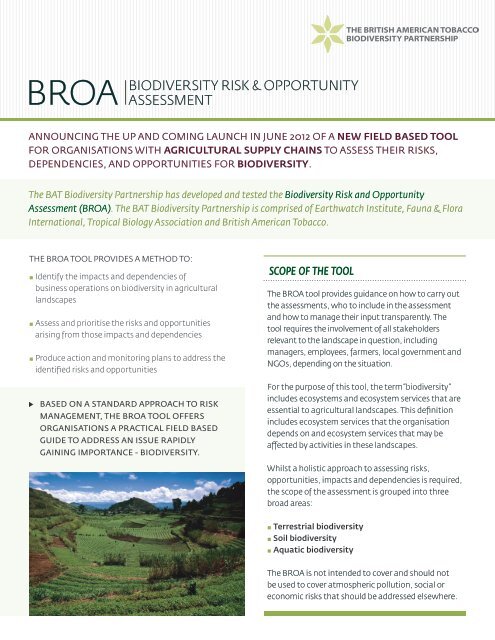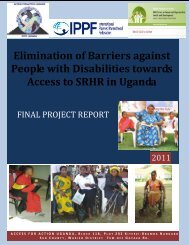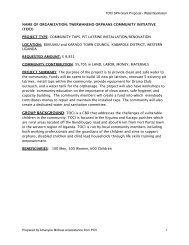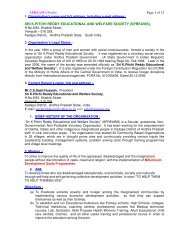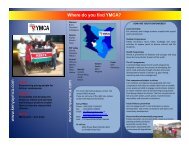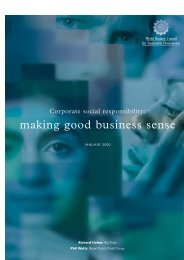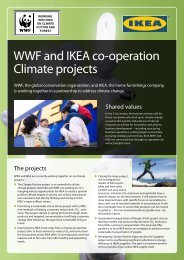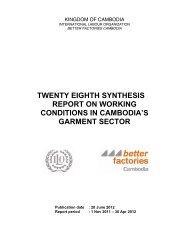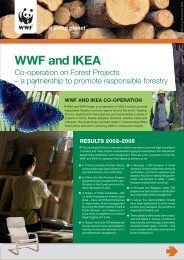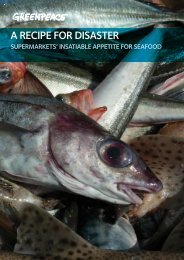BIODIVERSITY RISK & OPPORTUNITY ASSESSMENT - Global Hand
BIODIVERSITY RISK & OPPORTUNITY ASSESSMENT - Global Hand
BIODIVERSITY RISK & OPPORTUNITY ASSESSMENT - Global Hand
You also want an ePaper? Increase the reach of your titles
YUMPU automatically turns print PDFs into web optimized ePapers that Google loves.
<strong>BIODIVERSITY</strong> <strong>RISK</strong> & <strong>OPPORTUNITY</strong><br />
BROA <strong>ASSESSMENT</strong><br />
ANNOUNCING THE UP AND COMING LAUNCH IN JUNE 2012 OF A NEW FIELD BASED TOOL<br />
FOR ORGANISATIONS WITH AGRICULTURAL SUPPLY CHAINS TO ASSESS THEIR <strong>RISK</strong>S,<br />
DEPENDENCIES, AND OPPORTUNITIES FOR <strong>BIODIVERSITY</strong>.<br />
The BAT Biodiversity Partnership has developed and tested the Biodiversity Risk and Opportunity<br />
Assessment (BROA). The BAT Biodiversity Partnership is comprised of Earthwatch Institute, Fauna & Flora<br />
International, Tropical Biology Association and British American Tobacco.<br />
THE BROA TOOL PROVIDES A METHOD TO:<br />
▪ Identify the impacts and dependencies of<br />
business operations on biodiversity in agricultural<br />
landscapes<br />
▪ Assess and prioritise the risks and opportunities<br />
arising from those impacts and dependencies<br />
▪ Produce action and monitoring plans to address the<br />
identified risks and opportunities<br />
▶ BASED ON A STANDARD APPROACH TO <strong>RISK</strong><br />
MANAGEMENT, THE BROA TOOL OFFERS<br />
ORGANISATIONS A PRACTICAL FIELD BASED<br />
GUIDE TO ADDRESS AN ISSUE RAPIDLY<br />
GAINING IMPORTANCE - <strong>BIODIVERSITY</strong>.<br />
SCOPE OF THE TOOL<br />
The BROA tool provides guidance on how to carry out<br />
the assessments, who to include in the assessment<br />
and how to manage their input transparently. The<br />
tool requires the involvement of all stakeholders<br />
relevant to the landscape in question, including<br />
managers, employees, farmers, local government and<br />
NGOs, depending on the situation.<br />
For the purpose of this tool, the term “biodiversity”<br />
includes ecosystems and ecosystem services that are<br />
essential to agricultural landscapes. This definition<br />
includes ecosystem services that the organisation<br />
depends on and ecosystem services that may be<br />
affected by activities in these landscapes.<br />
Whilst a holistic approach to assessing risks,<br />
opportunities, impacts and dependencies is required,<br />
the scope of the assessment is grouped into three<br />
broad areas:<br />
▪ Terrestrial biodiversity<br />
▪ Soil biodiversity<br />
▪ Aquatic biodiversity<br />
The BROA is not intended to cover and should not<br />
be used to cover atmospheric pollution, social or<br />
economic risks that should be addressed elsewhere.
<strong>BIODIVERSITY</strong> <strong>RISK</strong> AND <strong>OPPORTUNITY</strong> <strong>ASSESSMENT</strong><br />
WHY THE NEED TO CONDUCT A BROA<br />
WHO IS IT FOR<br />
Organisations with agricultural supply chains are<br />
dependent on the continued functioning of healthy<br />
biodiversity, yet their environmental footprint may<br />
threaten what they depend on. It therefore is good<br />
practice and makes sense for these organisations to<br />
assess how they impact and depend on biodiversity.<br />
Information gathered can then be used to produce<br />
Action and Monitoring Plans to minimise their impact<br />
on biodiversity whilst seeking opportunities for a<br />
positive contribution to biodiversity conservation, vital<br />
for sustainable development.<br />
Completing a BROA allows an organisation to<br />
identify, prioritise and mitigate risks in a planned,<br />
straightforward and efficient manner. The tool’s<br />
added value comes from its ability to identify,<br />
prioritise and exploit opportunities that might not<br />
otherwise have been recognised. With increasing<br />
regulation and the opening up of new markets<br />
regarding biodiversity and ecosystem services,<br />
early adopters of BROA may have a competitive<br />
advantage over others.<br />
The BROA is for use by anyone responsible for<br />
managing agricultural operations and thus for the<br />
biodiversity in and around those operations. It is<br />
applicable to a broad range of crop types.<br />
WHAT KIND OF INFORMATION DOES<br />
IT DELIVER<br />
The BROA can provide information on a number of<br />
different levels. For example it can facilitate:<br />
▪ Identification of a high risk across a growing<br />
operation that requires immediate attention<br />
▪ Identification of new opportunities in and around<br />
the growing region<br />
▪ Identification of ecosystem service dependency for<br />
the growing operations that are at risk.<br />
WHAT IS THE BENEFIT OF CONDUCTING A BROA<br />
▪ Experience built within the organisation in<br />
identifying and evaluating biodiversity and<br />
ecosystem services risks and opportunities<br />
▪ Establishing collaborations with other stakeholders<br />
such as networks of NGOs, academics and<br />
community groups active on the issues in your area<br />
of operations<br />
▪ Insight into new opportunities around biodiversity<br />
and ecosystem services<br />
▪ Improved performance on an emerging issue within<br />
the private sector and actions taken to address it<br />
▪ Prioritisation of action for an international company<br />
at a global level once conducted across a sample of<br />
the supply chain<br />
2
FLOW CHART OF THE BROA PROCESS<br />
STEPS<br />
PHASE 1- PLANNING &<br />
INFORMATION GATHERING<br />
PHASE 2 – IDENTIFYING, INVESTIGATING &<br />
PRIORITISING <strong>RISK</strong>S & OPPORTUNITIES<br />
PHASE 3 - ACTION & MONITORING<br />
PLANS<br />
1. Planning<br />
▪ Identify BROA Project Team and prepare draft BROA plan, inc. budgets &<br />
timelines for approval<br />
▪ Address training needs<br />
▪ Map stakeholders<br />
▪ Recruit Conservation Partner<br />
2. Desk based information gathering<br />
▪ Gather & collate baseline internal & external data (contacting stakeholders<br />
as required)<br />
▪ Undertake mapping exercise of operations against biodiversity<br />
1. Initial stakeholder engagement & mandatory risk filter<br />
▪ Complete initial stakeholder engagement<br />
▪ Start to identify risks & opportunities<br />
▪ Complete mandatory risk filter<br />
2. Risk & opportunity site surveys<br />
▪ Complete working tables Phase 2 Step 2 with more information on<br />
identified risks & opportunities<br />
▪ Use mapping, working tables & advice from stakeholders to guide focus of<br />
site surveying<br />
▪ Undertake site surveys & stakeholder interviews/workshops to establish<br />
most important risks & opportunities<br />
▪ Update the working tables with evidence collected from Site Surveys<br />
3. Risk & opportunity prioritisation (scoring)<br />
▪ Complete working tables Phase 2, Step 3, prioritising risks & opportunities<br />
for Action & Monitoring Planning<br />
▪ Consult stakeholders on risk & opportunity prioritisation<br />
▪ Produce Executive Summary of results<br />
▪ Present to Top Team for approval<br />
1. Preparing & gaining approval for Action & Monitoring Plans<br />
▪ Complete Action & Monitoring Plan working table producing SMART Plans<br />
for all high & medium risks (and other prioritised) risks & opportunities<br />
▪ Share Plans with key internal and external stakeholders<br />
▪ Gain Top Team sign-off of Action & Monitoring Plans<br />
▪ Escalate dependency issues which cannot be addressed to Centre<br />
2. Implementing Action & Monitoring Plans<br />
▪ Address capacity needs for Plan implementation, including on-going<br />
monitoring<br />
▪ Outsource Plan tasks as necessary<br />
▪ Record Plan progress with evidence in Action & Monitoring working table<br />
▪ Report Plan status in line with BAT review process<br />
▪ Continue ongoing engagement with stakeholders; regular sharing of<br />
Action and Monitoring Plan progress<br />
OUTPUTS & INPUTS<br />
▶ Approved BROA plan with<br />
preparatory steps completed for Phase<br />
2 (e.g. training, budgets & resourcing)<br />
▶ Conservation Partner appointed<br />
▶ Outline map overlaying operational<br />
sites & potential interactions with<br />
biodiversity<br />
▶ Key stakeholder biodiversity issues<br />
identified<br />
▶ Risks identified from mandatory filter<br />
added to risk working table<br />
▶ Completed working tables Phase 2<br />
Step 2 with details and evidence for<br />
risks & opportunities<br />
▶ Completed Working Tables Phase 2<br />
Step 3<br />
▶ Executive Summary<br />
▶ Approved Risks & opportunities for<br />
Action and Monitoring Plans<br />
▶ Completed working tables Phase 3<br />
Step 1<br />
▶ Approved Action & Monitoring Plans<br />
(June)<br />
▶ Greater dependency issues escalated<br />
▶ Actions implemented and<br />
monitoring results recorded in Action<br />
& Monitoring Plan working table<br />
▶ Reports on Action & Monitoring Plan<br />
Progress<br />
3
<strong>BIODIVERSITY</strong> <strong>RISK</strong> AND <strong>OPPORTUNITY</strong> <strong>ASSESSMENT</strong><br />
WHAT DOES THE BROA CONTAIN<br />
The BROA includes a step by step Guide for the three phases of the process and Working Tables in excel format to<br />
record and score your findings.<br />
The Guide includes aims and objectives for each phase, step by step instructions for each activity and a checklist of<br />
activities at the end of each phase. It also contains a series of ‘How to’ documents that cover recommendations on<br />
sample size selection, how to conduct site surveys, engage stakeholders and develop a monitoring process.<br />
The Working Tables include a Mandatory Risk Filter of topics that have to be ruled in or out before moving on (a vital<br />
step to be sure nothing is missed) as well as Working Tables for Risks and Opportunities, and matrices to guide the<br />
scoring process.<br />
DEVELOPMENT OF THE TOOL :<br />
A screen shot of the Mandatory Risk Filter Working Table<br />
The BAT Biodiversity Partnership developed and tested<br />
the tool. With the support of the BAT Biodiversity<br />
Partnership, the tool has been developed and refined<br />
from field work in 20 countries to date.<br />
The tool has received independent external review<br />
from UNEP - WCMC, Richard Perkins at WWF-UK and<br />
one other biodiversity and agricultural specialist with<br />
extensive experience globally.<br />
WHAT IS THE OUTPUT OF THE BROA<br />
At the end of the assessment the organisation will<br />
have Action and Monitoring plans for each identified<br />
high and medium risk and opportunity.<br />
CONTACT<br />
For more information, you can contact us using the<br />
general enquiry form through the BAT BP website:<br />
http://www.batbiodiversity.org<br />
4


